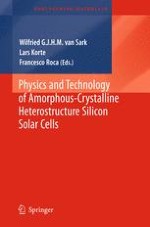2012 | OriginalPaper | Chapter
Intrinsic and Doped a-Si:H/c-Si Interface Passivation
Author : Stefaan De Wolf
Published in: Physics and Technology of Amorphous-Crystalline Heterostructure Silicon Solar Cells
Publisher: Springer Berlin Heidelberg
Activate our intelligent search to find suitable subject content or patents.
Select sections of text to find matching patents with Artificial Intelligence. powered by
Select sections of text to find additional relevant content using AI-assisted search. powered by
The performance of crystalline silicon (
c
-Si) heterojunction (SHJ) solar cells critically depends on the properties of the deposited hydrogenated amorphous silicon (
a
-Si:H) films. Surface passivation is an important role they need to fulfill. Additionally, the
a
-Si:H films should also act as efficient emitter and back surface field (BSF). In this chapter, we focus on the electronic passivation properties of the
a
-Si:H/
c
-Si interface. First, relevant literature on
c
-Si surfaces is briefly reviewed, including the effect of hydrogenation of surface states. This is followed by a discussion of how electronic surface recombination is calculated and measured. Recombination is mainly determined by electronic gap-states. The precise nature of these states is discussed both for the
c
-Si surface and for the
a
-Si:H bulk. Next, the physical passivation mechanism of intrinsic
a
-Si:H is elucidated. It is concluded that it stems from chemical surface state passivation by hydrogen, similar to defect passivation in the
a
-Si:H bulk. For these films, it is also argued how epitaxial growth may detrimentally influence the passivation quality. For heterojunction devices this has its importance, as the deposition of device-grade
a
-Si:H is often very close to the transition to epitaxial growth. A following section focuses on the effect of doping of the amorphous films. Doping is principally expected to improve the passivation quality further, as it should give rise to additional field-effect passivation. Here, it is discussed why this is not necessarily the case, as doping is also linked to Fermi-level dependent Si–H bond rupture in the films. A compromise between doping and surface-passivation may be obtained by employing an intrinsic buffer layer between the doped film and the wafer. By using intrinsic buffer layers, values for the energy conversion efficiency as high as 23% were reported to date for SHJ devices.
